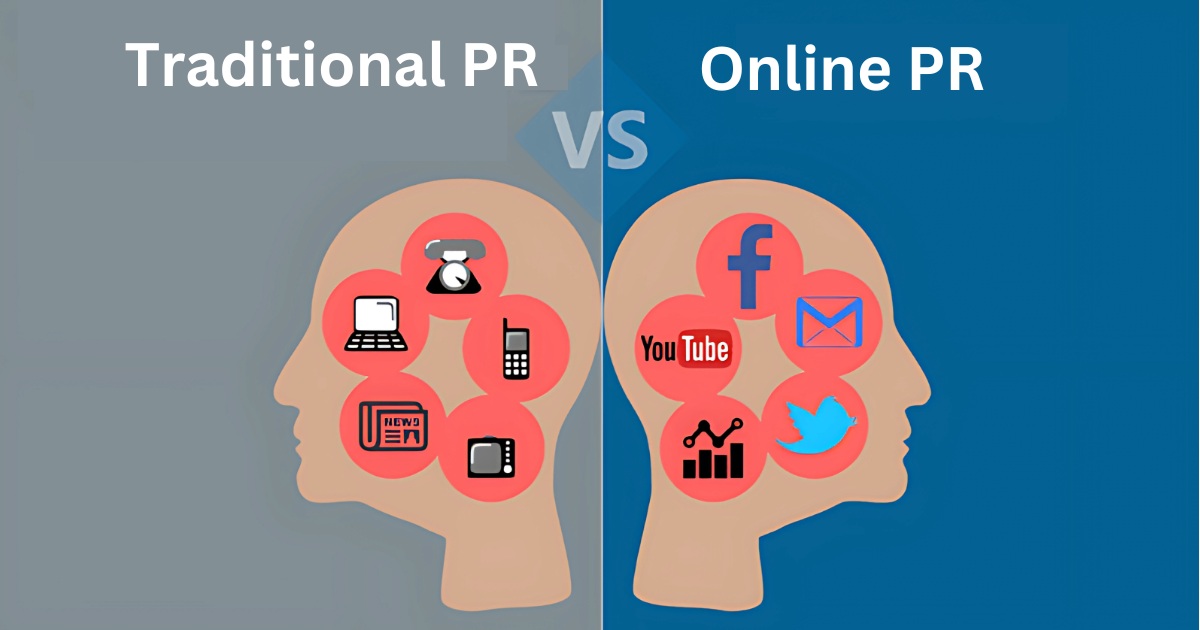In today’s world, public relations (PR) plays an important role in shaping a brand’s public image and building brand awareness. As businesses strive to connect with their target audience, understanding the nuances between traditional PR and digital PR becomes essential.
This article explores these two approaches, highlighting their differences and how they can be effectively utilized in a modern PR strategy.
What is Traditional PR, and Why is it Important?
Traditional public relations involves using offline channels such as print newspapers, magazines, radio, and television to disseminate important messages to the public.
This method focuses on media relations and securing media coverage through press releases, conferences, and PR events. Despite the rise of digital media, traditional PR methods remain important for reaching audiences that prefer traditional media outlets.
What is Digital PR, and Why is it Important?
Digital PR uses online channels like social media platforms, online publications, and digital press to enhance a brand’s online presence. It involves content creation, influencer marketing, and digital marketing strategies to engage with audiences directly. Digital PR is vital in today’s digital landscape as it helps in building domain authority, generating referral traffic, and improving organic search rankings.
The Difference Between Digital PR Vs. Traditional PR
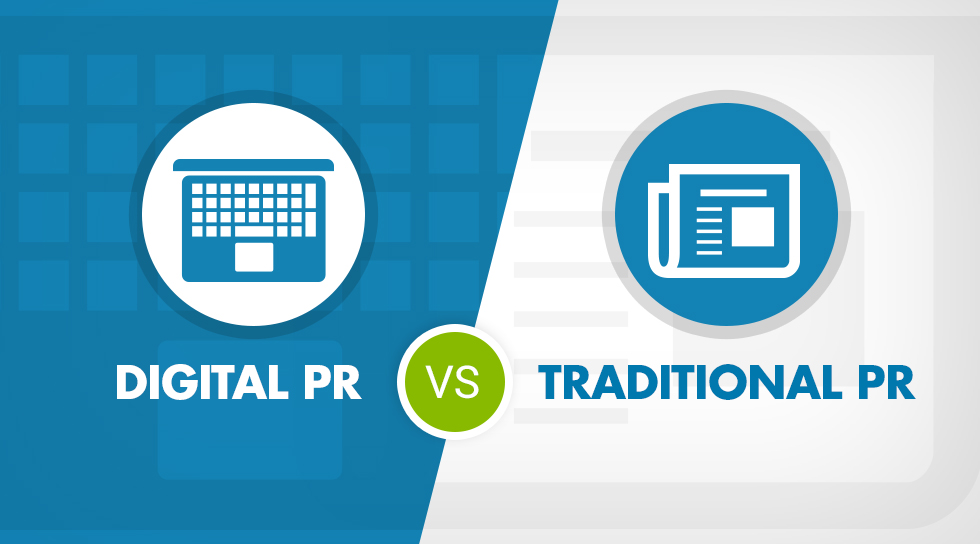
Online Vs. Offline Relationships
Traditional PR focuses on building strong ties with journalists, editors, and producers through personal communication, often involving face-to-face meetings or phone calls.
These relationships help secure media coverage in traditional media outlets such as newspapers, magazines, and TV.
In contrast, digital PR builds connections online with bloggers, influencers, and content creators using social media platforms and email outreach. This approach enables brands to directly interact with their audience through online channels like social media, enhancing audience engagement and brand awareness.
Messaging
Traditional PR messaging is typically formal and structured, relying on press releases and mass media to shape public opinion. It emphasizes consistency and professionalism to appeal to traditional media outlets.
Digital PR, however, allows for more creative and dynamic messaging tailored to specific audiences.
Through digital channels like social media and blogs, brands can create personalized messages that resonate with their target audience while also including SEO strategies to boost online visibility.
It’s All in the Numbers
Digital PR offers measurable results through tools like Google Analytics, enabling PR professionals to track organic traffic, referral traffic, and audience interaction. Metrics such as backlinks, domain authority, and keyword rankings provide insights into campaign success.
Traditional PR relies on less tangible metrics like media reach, sentiment analysis, or average readership figures from traditional media outlets. This makes it harder to quantify the direct impact of traditional PR campaigns.
Interaction and Engagement
Audience interaction is a key differentiator between the two approaches.
Digital PR thrives on two-way engagement through social media platforms where brands can respond to comments, share posts, and participate in conversations. This fosters a sense of community and relatability.
Traditional PR methods are more one-sided, focusing on delivering messages through press conferences or print newspapers without immediate feedback from the audience.
Longevity
Digital PR content often has a lasting presence online. Blog posts, articles, or social media updates remain accessible indefinitely, continuing to drive organic growth over time.
Traditional PR campaigns, such as those in print newspapers or radio ads, are more transient; once published or aired, they lose visibility unless archived or repurposed for future use.
Key Stakeholders
Bloggers and Influencers
Bloggers and social media influencers play a vital role in digital PR by promoting brands through their established online platforms. Their ability to build trust with their followers makes them effective in driving brand awareness and improving SEO through backlinks.
Content Creators
Content creators are essential for creating high-quality content that aligns with a brand’s voice and values. They produce engaging materials such as videos, infographics, or blog posts that resonate with the target audience across digital channels.
Journalists and Reporters
Both traditional and digital PR rely on journalists for media coverage. In traditional PR, journalists are approached for features in newspapers or magazines. In digital PR, they are engaged for online publications or news sites that can link back to the brand’s website.
SEO Managers
In digital PR campaigns, SEO managers collaborate closely to ensure content aligns with search engine optimization strategies.
Securing backlinks from high-authority sites and optimizing keywords in press releases or articles helps improve domain authority and organic search rankings.
Event Organizers
Event organizers are significant in traditional PR campaigns where press conferences or product launches are central strategies.
They also play a role in digital campaigns by integrating virtual events or webinars that combine offline experiences with online engagement opportunities.
Understanding these differences and stakeholders’ roles within each approach, businesses can tailor their public relations strategies effectively to meet their goals in today’s competitive landscape.
Digital Vs Traditional PR Pros and Cons
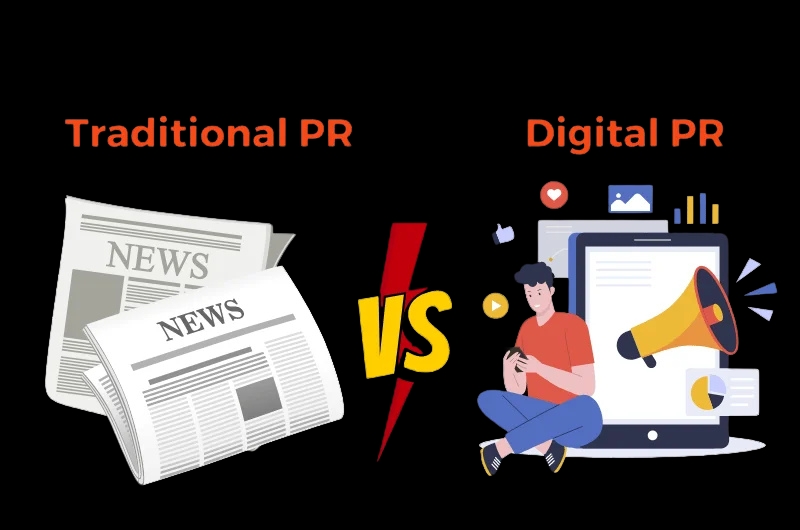
Both traditional PR and digital PR aim to shape public opinion, build brand awareness, and improve a brand’s public image. However, each has its strengths and weaknesses. Choosing the right approach depends on your target audience, campaign goals, and available budget.
Digital PR Pros
- Measurable Results: Digital PR allows PR professionals to track campaign success using tools like Google Analytics. Metrics such as organic traffic, referral traffic, domain authority, and audience engagement provide clear insights into how well your digital PR strategies are working.
- Wider Reach: Through online channels like social media platforms and online publications, digital PR can reach global audiences instantly. This makes it easier to connect with diverse groups and expand brand awareness beyond geographical boundaries.
- Real-Time Interaction: Digital public relations enable direct audience interaction through social media platforms. Brands can respond to comments, share updates, and engage with their target audience in real-time, fostering stronger connections.
- SEO Benefits: Digital PR helps improve search engine rankings by building high-quality backlinks from reputable websites. This boosts organic search visibility and drives long-term organic growth.
Digital PR Cons
- Content Overload: The digital media landscape is highly saturated, making it challenging for brands to stand out. Constant content creation is needed to maintain visibility across online platforms.
- Rapid Changes: Digital channels evolve quickly, requiring PR practitioners to stay updated with trends and algorithms. Strategies that work today may become outdated tomorrow.
- Potential for Negative Feedback: Social media platforms allow for immediate audience interaction, but this also means negative feedback or crises can spread quickly if not managed effectively.
Traditional PR Pros
- Credibility: Traditional public relations often rely on traditional media outlets like print newspapers, radio, and TV, which are perceived as more credible sources of information by certain audiences. Media coverage in these outlets can significantly enhance a brand’s public image.
- Established Relationships: Traditional PR methods focus on building strong ties with journalists and reporters who have access to mass media audiences. These relationships can lead to consistent media coverage for important messages or product launches.
- High-Impact Moments: Traditional methods like press conferences or PR events create memorable experiences that leave a lasting impression on the target audience, especially during product launches or crisis communication efforts.
Traditional PR Cons
- Limited Audience Engagement: Unlike digital channels, traditional methods do not allow for real-time interaction with the target audience. Communication is one-sided, making it harder to gauge public opinion or adjust messaging.
- Difficult to Measure Success: Traditional PR campaigns rely on metrics like average readership or estimated reach from traditional media outlets, which are less precise compared to the detailed analytics available in digital campaigns.
- Higher Costs: Organizing press conferences, producing print ads, or securing TV spots can be expensive compared to the cost-effective nature of digital marketing strategies.
- Shorter Lifespan of Content: Media coverage in traditional outlets often has a limited lifespan—once a newspaper is read or a TV segment airs, the content loses visibility unless archived or repurposed.
Traditional Or Digital, Which is Better For You?
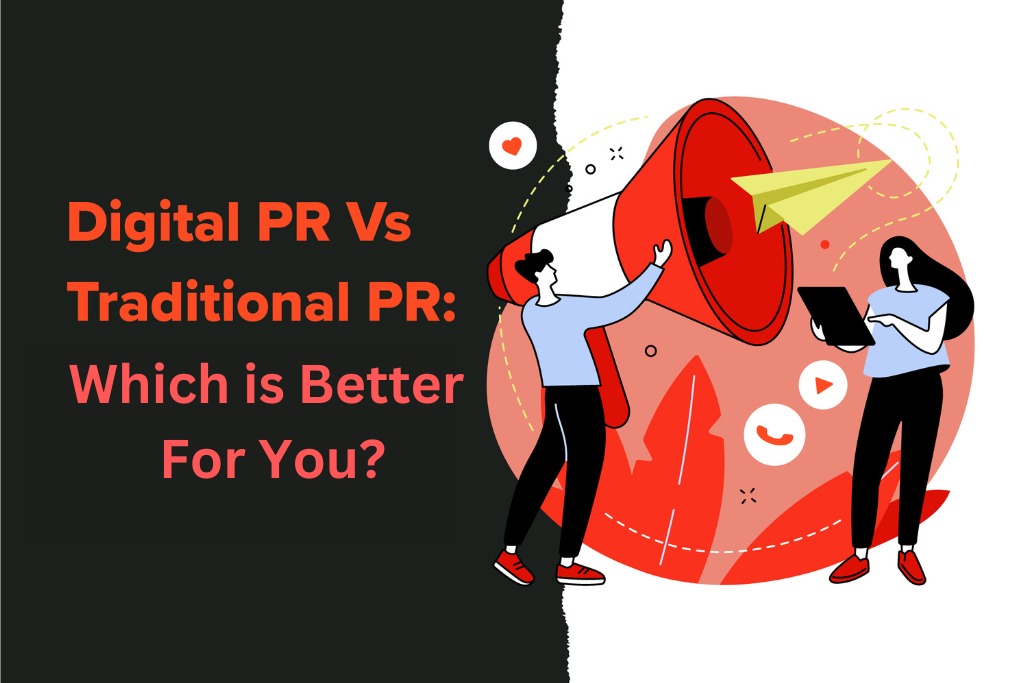
Choosing between traditional PR and digital PR depends on your target audience, campaign goals, and budget. Traditional PR excels in building credibility through trusted media outlets like newspapers and TV, making it ideal for audiences that consume traditional media.
On the other hand, digital PR offers cost-effective solutions with measurable results, making it perfect for reaching a global audience through social media platforms and online publications.
Both approaches have their strengths, so the best choice often involves combining them for a well-rounded PR strategy.
What Can Digital Do Better Than Traditional?
Digital PR outshines traditional methods in several ways. It provides real-time audience interaction through social media platforms, allowing brands to respond quickly to feedback or public opinion.
Additionally, digital PR helps improve SEO by building backlinks and increasing domain authority, boosting organic traffic to your website.
It also offers precise targeting through online channels, ensuring your message reaches specific demographics while providing measurable results using tools like Google Analytics.
What Does Digital PR Do That Traditional PR Doesn’t?
Digital PR enables two-way communication with audiences, fostering engagement through comments, shares, and likes on social media platforms.
Unlike traditional PR, which relies on one-way messaging, digital PR allows brands to participate in ongoing conversations online. It also ensures content longevity—blogs and articles remain accessible indefinitely, driving referral traffic long after publication.
Furthermore, digital PR integrates seamlessly with other digital marketing efforts like content marketing and influencer campaigns.
How Can Traditional PR and Digital PR Work Together?

Traditional PR and digital PR can complement each other for maximum impact.
For example, a product launch can begin with traditional press coverage in newspapers or TV to establish credibility while simultaneously using digital channels like social media for broader reach and audience interaction. Digital PR can also enhance traditional campaigns by optimizing press releases for SEO or sharing event highlights online to extend their lifespan.
What Different Channels and Tools Are Commonly Used?
- Traditional Channels: Print newspapers, magazines, radio broadcasts, TV segments.
- Digital Channels: Social media platforms (e.g., Instagram, Twitter), blogs, online publications.
- Tools: Google Analytics for tracking website traffic; social media analytics tools for engagement metrics; email outreach platforms for connecting with influencers or journalists.
How Do You Measure A PR Campaign’s Success?
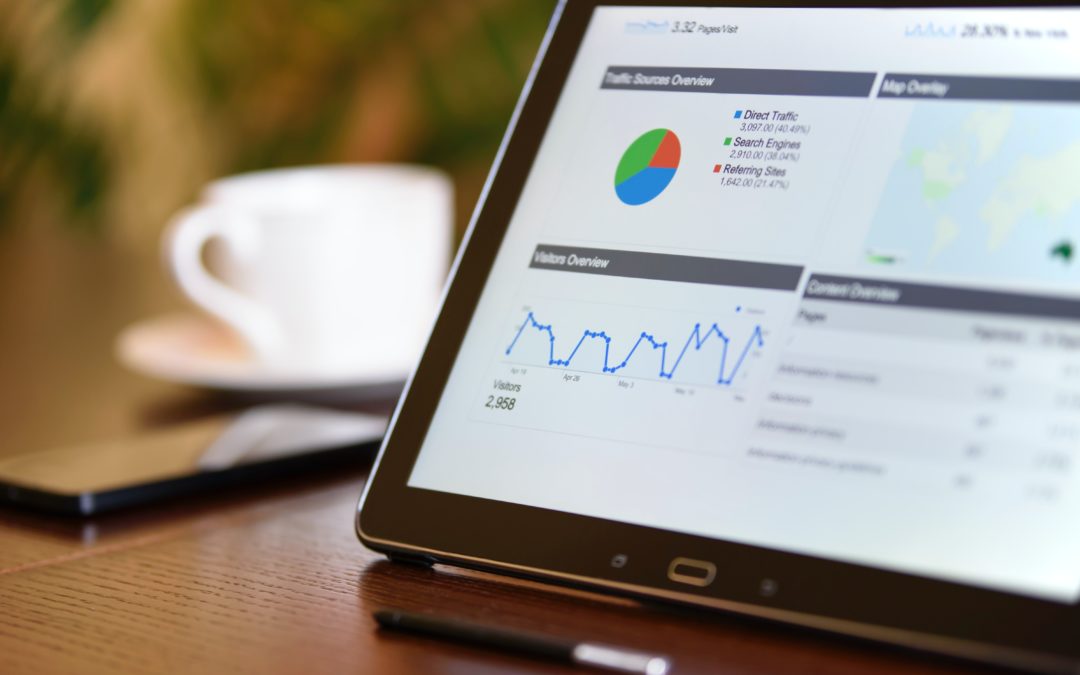
PR campaign success is measured through various metrics:
- Media Coverage: Track press clippings or mentions in traditional media outlets.
- Online Metrics: Use tools like Google Analytics to measure website traffic, referral traffic, and organic search improvements.
- Audience Engagement: Monitor interactions on social media platforms such as likes, comments, and shares.
- Sentiment Analysis: Evaluate whether the public’s perception of your brand aligns with your campaign goals.
- SEO Impact: Assess domain authority growth and the quality of backlinks generated by digital PR efforts.
By combining these evaluation techniques, you can determine the effectiveness of your traditional or digital public relations strategy while refining your future campaigns.
FAQ’s:
What Are the First Steps in Shifting From Traditional to Online PR?
To shift from traditional PR to online PR, start by identifying the digital channels where your target audience spends time, such as social media platforms or online publications.
Develop a digital marketing strategy that includes content creation, influencer marketing, and SEO-focused press releases. Use tools like Google Analytics to measure your PR efforts and adjust your approach based on audience interaction and referral traffic.
How Can Small Businesses Benefit From Online PR?
Online PR is a cost-effective way for small businesses to build brand awareness and improve their online presence.
By using social media platforms, blogs, and digital press, small businesses can reach their target audience directly without relying on expensive traditional media outlets.
Additionally, digital PR strategies can drive organic growth through quality content and backlinks that boost domain authority.
How Does Digital PR Enhance SEO?
Digital PR enhances SEO by building high-quality backlinks from online publications and reputable websites, which improves domain authority. It also helps increase organic search rankings by creating keyword-optimized content that drives organic traffic. Through strategic content marketing and media coverage on digital platforms, brands can achieve long-term visibility in search engines.
Can Traditional PR Still Be Effective in the Digital Age?
Yes, traditional PR remains effective in today’s world for certain audiences and goals. It works well for building credibility through trusted traditional media outlets like newspapers, TV, and radio.
Traditional PR is especially impactful for product launches or crisis communication when mass media coverage can shape public opinion quickly. Combining it with digital channels ensures a balanced and modern public relations strategy.
Conclusion
In today’s world, both traditional PR and digital PR play an important role in shaping a brand’s public image and building brand awareness.
While traditional PR excels in credibility and strong ties with traditional media outlets, digital PR provides measurable results, real-time audience interaction, and long-term benefits like improved SEO and organic growth.
Understanding their strengths and weaknesses, businesses can choose the right approach based on their target audience, campaign goals, and budget.
The best strategy often combines both methods—using traditional PR for impactful media coverage and digital PR for audience engagement through social media platforms and online channels. Together, they create a balanced PR strategy that enhances brand visibility, drives referral traffic, and fosters meaningful connections with important audiences.
Whether you’re launching a product or managing crisis communication, integrating these approaches ensures your PR efforts remain effective in today’s competitive landscape.

